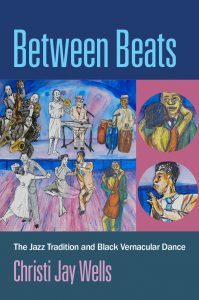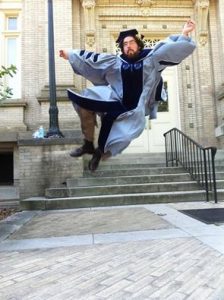
In the final edition of our May mini-series, Book Notes, we’re featuring alumnus Dr. Christi Jay Wells and their book Between Beats: The Jazz Tradition and Black Vernacular Dance, published by Oxford University Press on April 16, 2021.
Christi Jay Wells is assistant professor of musicology at Arizona State University’s School of Music and affiliate faculty with ASU’s Center for the Study of Race and Democracy. They received their doctorate in 2014 from the University of North Carolina at Chapel Hill where their dissertation on drummer/bandleader Chick Webb and swing music in Harlem during the Great Depression received the Society for American Music’s Wiley Housewright Dissertation Award and UNC’s Glen Haydon Award for an Outstanding Dissertation in Musicology. They have also received the Irving Lowens Article Award from the Society for American Music. A social jazz and blues dancer for over a decade, Wells regularly places highly in blues dance competitions and is a frequent lecturer and clinician at national and international events, having recently taught blues and jazz dance classes and lectured on dance history in Seoul, South Korea and Hong Kong. In addition to Between Beats, they have also published articles in the journals Women & Music, Jazz & Culture, Journal of the Society for American Music, and Daedalus as well as providing multiple chapters on jazz dance history topics for volumes in the Oxford Handbook series.

Can you give us a short synopsis of your book?
Dr. Wells: Between Beats chronicles jazz music’s relationship with social and popular dance as it shifts over the course of a century. Each chapter offers a dance-focused case study that makes some kind of historiographic intervention, as seeing jazz’s history through the presence and absence of dancing bodies helps us to see and to question the contours of jazz history’s dominant narratives. In particular, Between Beats challenges the idea that jazz was a form of popular dance music only in its distant past and that it lost its connection with dance as it became more accepted as a form of “art” or “concert” music. Rather, the case studies in Between Beats reveal a far more complex and fluid relationship between jazz music and a range of Black social dance traditions. The book also offers the concept of “choreographies of listening,” which employs ideas from the field of dance studies to frame listening as a fundamentally embodied and performative act whether a listener is up on their feet moving and shaking or seated and tapping their toe.
How do jazz and dance studies fit into your overall research interests?
Dr. Wells: Though I do have an undergraduate degree in classical voice, in many ways I regard myself as more of a dancer than a musician, even though musicology is my academic field. I’ve been a lindy hop dancer since I was nineteen years old, nearly twenty years ago, and it was through dancing that I found my interest in jazz music. So, my interest in jazz music is, in a fundamental way, routed through my passion for dancing, and the two are inseparably linked. As a scholar, I’m also very interested in the relationship between storytelling and systems of power, and particularly how racialized systems of power—in particular those present in academic institutions—influence the ways histories are shaped over time.
What inspired you to write this book in particular?
Dr. Wells: The seeds of this book were planted for me as an undergraduate student when I took my first jazz history class in college. The instructor presented a narrative that was either dismissive of or outright hostile to dance, and this felt so discordant both with the dance-focused jazz history I was learning as a lindy hop dancer and with my own embodied practice as a dancing listener. The whole idea that jazz really “got good” or became a serious, artistic music when bebop became too challenging for dancers just never sat right with me. The more I explored the topic as a researcher, the more it became clear that the whole idea that bebop wasn’t considered dance music isn’t actually true, or at least it’s just one story among many and one that weights the perspective of a certain subculture of “hip” white fans far more heavily than that of the Black teenagers who absolutely regarded bebop as popular dance music in the 1940s and 1950s. So, that’s one example of what the book explores and the types of questions it asks: what canonic narratives about jazz’s relationship with dance are either outright false or at least highly skewed, and what kinds of work do those stories do?

Were there any surprises along the journey of writing this book?
Dr. Wells: The process of doing the research was full of surprises and discoveries, as history research should be, but one of the biggest surprises for me in working on this book was how my own perspectives and goals shifted as I wrote it. Initially, I was pretty driven to position dancing listeners as a kind of protagonist and still/seated listening as a kind of antagonist. However, the more I worked on it, the more it became clear to me that if I was going to criticize other white authors for erasing the lived experiences of Black audiences, or at least for conscripting their bodies to serve some kind of monolithic narrative, I had to walk my talk and challenge myself not to fall into the same trap. So throughout I tried to make space for the heterogenous dispositions toward dancing that Black musicians and audiences have had at various points in jazz’s history. Another major surprise involving my own shifting perspective that I really should mention is that I went through a process of gender transition as I was writing this book; I understood myself to be a cisgender man when I started researching it, and I now know myself to be a nonbinary transfeminine person. So, I will say that writing reflexively and being ever mindful of one’s subject position becomes quite a task when that subject position becomes profoundly and deeply unmoored mid-project!
If readers could take away one thing from this book, what do you hope it would be?
Dr. Wells: I hope readers take away from this book that listening is never a neutral act, and that all forms of listening involve our active, embodied participation in, or perhaps resistance to, culturally situated norms. The ways we listen, and the ways we don’t listen, communicate a set of values, and often they reveal a disposition—positive or negative—toward bodies and movement that’s worth exploring and reflecting upon both individually and collectively. I also hope readers take away that narratives don’t just detail and explicate practices, but rather that narratives and practices always exist in dynamic relationship with one another, and that this is evident throughout jazz’s history (one big reason why jazz historiography remains an important project.)
